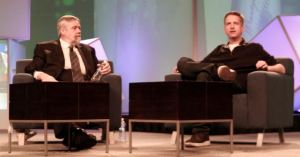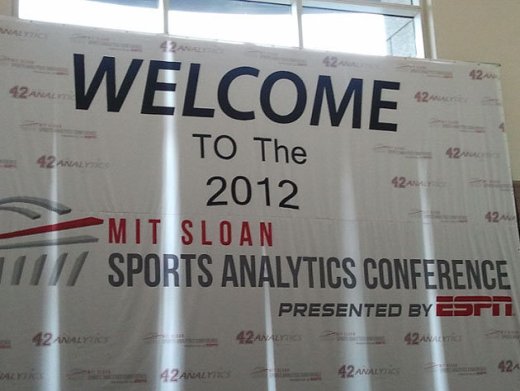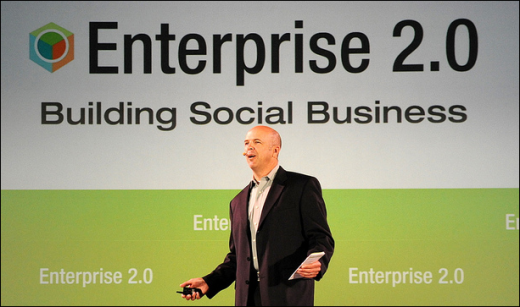2,200 sports nerds gathered in Boston this weekend to talk about sports analytics at the annual MIT Sloan Sports Analytics Conference. Here, a bunch of “wicked smaht” people talk about a number of things that would likely bore you to tears if you’re not a fan of sports geekery. It’s the people that work in front offices and behind the scenes discussing regression analysis, paradigms of alternative thought, and correlation (not so much causation).
Rather than give you the play-by-play, I go over general highlights and observations from the perspective of a sports fan and digital analyst.

Bill James is the godfather of baseball analytics, Scott Boras is the puppeteer. Bill James is the clear MVP of the event; in fact, no part of this conference would exist if it weren’t for his devotion to studying the analytics of baseball since 1975. His one-on-one BS report with Bill Simmons covered his rise from part-time stats geek to saint of sports nerds. For his readers at the time, James’ work was a revelation, providing the statistical tools that let fans grasp baseball better than some of the sports executives did. By 2002, James even became a baseball insider himself, as an adviser to the Boston Red Sox. During the hour long interview with Simmons, James reflected on the difference between superstition and religion. –“A superstition is narrow and focused. You believe that if I do this, something bad will happen to my team. On the other hand, a religion is elaborate and intricate. It fills in all of the boxes, with philosophy, with the wisdom of previous generations and it’s complicated and it heals itself. The way that people think about baseball is much more a religion than a superstition and for that reason it’s much harder to change the way people think”. With that cleared up you know where to find me now, at the church of the absolute, all-powerful, mighty, omnipotent, Red Sox Nation.
Super-agent Scott Boras didn’t go unnoticed either and clearly swept the baseball analytics panel. When asked how he evaluates players, he claimed, “it’s like baking a cake where the ingredients are unknown.” Take that, pie lovers. Since his discussion I’ve grown a new found respect for Boras. This man is able to move his chess-piece clients around the MLB because of the potential future that statistical evidence can show. No, it’s not smoke and mirrors, but it sometimes seems that way. Because of his ability to use advanced statistics and scout the highest of clientele, he’s created a monopoly in business representing baseball players. No emotion involved.
Jeff Van Gundy dominated. Everything he touched was comedic gold. He talked about the role stats could play in getting a message across to a player. “Stats can be used as evidence that both the coach is right and that he’s not just picking on a player for no reason.” Van Gundy explained that when he didn’t have a statistic readily available to enforce his point, he would just make one up. “There are no absolutes in analytics. So stop asking. Enjoy the beautiful, beautiful gray area.” Jeff Van Gundy unlike many fans of basketball is not a Jeremy Lin fan. He went on to discuss how Lin has been in the NBA for a good portion of last season, how other NBA players have taken longer, harder paths to the big time than he has. Michael Wilbon provided his 2 cents saying Lin is “making people look at basketball in a different way.” Meaning Lin’s story has illustrated how international the game has become. Um, Lin was raised in Palo Alto, guys. Not China. Not even Taiwan.
Drew Carey is a smart shopper, but doesn’t give out any Price is Right tips. Drew managed to be both entertaining and enlightening. He acknowledged the soccer structure in the USA isn’t good for MLS. Among many changes he has championed, he revealed that his GM is under contract for 4-years. At each interval fans will get to vote based on their performance if they feel they have done a good job. So, remember that next time you read the sports section and complain about a trade or why someone was sent down to the minor league. If you are a Seattle Sounders season ticket holder, you the fan have a say in the future of that GM. I was thoroughly impressed with the ability for a veteran celebrity to take over an organization and focus his power and money on setting a culture that sets your management team up for success. Normally Drew lives by the mantra that, “everything’s made up and the points don’t matter,” but he’s clearly changed that here.
ESPN is by far the best thing going for sports statistics today, and also the worst. The bottom line is that analytics are expensive. They take time and resources to compute and are far from exact science. It’s not an incredibly profitable topic for ESPN but it’s something that needs to be completed, in part because it is good for the fans. Without ESPN’s influence, this conference could have never grown at its current near-exponential rate (roughly 150 students 5 years ago, to 2,200 and a waiting list this year). Every nerd should appreciate what ESPN has done. However, there were a few inescapable panels promoting new ESPN measures like Total QBR and some new college Basketball Performance index (BPI). I trust the approaches to these measures are sound, but the delivery was so forceful, so absolute that it turned me off fairly quickly. When you have your name on everything in the room you can get away with this, but it is not always accepted with great regard. Overall, their influence on this conference was almost certainly a net positive.
Amusing observations:
Simmons is much nerdier in person than I expected. He’s super skinny and awkward when he walks around. He has a complete smart ass sense of humor and loved making fun of the Van Gundy/Morey history. Also, Mark Cuban missed Friday’s events and was running late Saturday. Don’t know that has any relevance to any impending trade activity but just found it interesting. By the way, this conference is a super well-run event. You lost track of all the sports celebrities from ESPN that you see walking around. I encourage all of you to check it out if you get the opportunity.
I didn’t leave a stone unturned in my 48 hours in Boston this weekend. Truly met some great people and caught some insight from the juggernauts of the business. #SSAC delivered immense knowledge and I’ve gained loads of respect for those spending exponentially more time running statistical models than my job demands. One of the major takeaways for me is that there seems to be a lot of crossover between digital analytics and sports analytics. Maybe the tools and product are a little bit different, but the principles and challenges remain the same. You still have to figure stuff out. Statistics allow you to communicate everything into words that coaches (or in my case, executives) could easily understand. An apparent problem in sports analytics is the lack of historical clean data. Most colleges and some high schools will collect and report out on players, but the challenge lies within how to adjust for the different levels of play. In digital advertising we are on a constant journey searching for more relevant, and historical data as well as how to common size for changing trends. Sports nerds: we hear your problems loud and clear.










